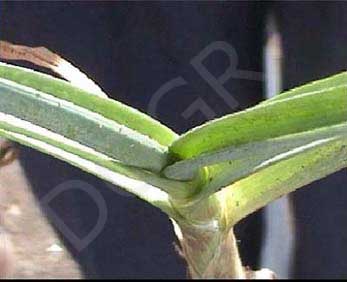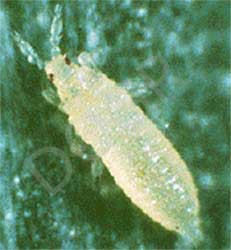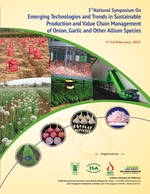Pest and disease management
Pest and disease management is crucial for obtaining higher marketable bulb yield and good quality bulbs. Major pests and diseases of garlic, their symptoms and management practices are given in Table.
Table . Important pests and diseases, their symptoms and control measures
|
Pest/disease |
Pest |
Symptoms |
Control measures |
|
Insects |
Thrips (Thrips tabaci) |
1. Thrips infestation at an early stage (transplanting to 45 days) can be identified by curling and twisting of leaves. 2. Typical symptom is the presence of white or silvery patches on the leaves. 3. In severe infestation, whole plant looks blemished and turns white. |
1. Planting of two rows of maize or one outer row of maize and an inner row of wheat as a barrier crop surrounding garlic crop (250 sq. m) at least 30 days prior to planting of garlic helps to block the movement of adult thrips. 2. Spray insecticides Profenofos (0.1%), Carbosulfan (0.2%) or Fipronil (0.1%) when thrips population crosses the economic threshold level of 30 thrips/plant. |
|
Eriophyid mite (Aceria tulipae) |
1. Leaves do not open completely. Whole plant shows stunting, twisting, curling and yellow mottling. 2. Mottling is seen mostly on the edges of the leaves. |
Spray Dicofol (0.2%) or sulphur (0.05%) as soon as the symptoms appear. Repeat the spray after 15 days, if necessary. |
|
|
Red spider mite (Tetranychus urticae) |
1. White discoloration of leaves with small patches of faeces, eggs, larvae and adult mites. 2. Yellow or bronze spots on the leaves. 3. Spider webbing on leaves |
Spray Dicofol (0.2%) or sulphur (0.05%) as soon as the symptoms appear. Repeat the spray after 15 days, if necessary. |
|
|
Nematode |
Stem and bulb nematode (Ditylenchus dipsaci) |
1. D. dipsaci enters through stoma or plant wounds and create galls or malformations in plant growth. This allows for the entrance of secondary pathogens like fungi and bacteria. 2. Symptoms are stunted growth, discoloration of bulbs, and swollen stems. |
1. Bulbs that show signs of disease should not be planted 2. Proper sanitation of fields and tools is essential because this nematode can survive and reproduce in infected plants and residues. |
|
Fungal diseases |
Purple bloch (Alternaria porri) |
1. Initially small, elliptical lesions or spots on leaves that often turn purplish-brown and are surrounded by chlorotic margin. 2. If the spots enlarge, chlorotic margin extend above and below the actual lesion. Lesions usually girdle leaves, causing them to fall over. Lesions may also start at the tips of older leaves. |
Spay Mancozeb @ 0.25% or Tricyclazole @ 0.1% or Hexaconazole @ 0.1% or Propiconazole @ 0.1% at 10-15 days intervals from 30 days after planting or as soon as disease appears |
|
Stemphylium blight (Stemphylium vesicarium) |
1. Small yellow to orange flecks or streaks develop in the middle of the leaf which soon develop into elongated, spindle shape to ovate elongate diffused spots surrounded by characteristic pinkish margin. 2. The spots progress from the tip to the base of the leaves. The spots coalesce into extended patches, blighting the leaves and gradually the entire foliage. |
Spay Mancozeb @ 0.25% or Tricyclazole @ 0.1% or Hexaconazole @ 0.1% or Propiconazole @ 0.1% at 10-15 days interval from 30 days after planting or as soon as disease appears |
|
|
White rot (Sclerotium cepivorum) |
1. Yellowing and dying back of leaf tips. 2. Roots are normally destroyed. Superficial white fluffy mycelium may be present on decaying scales. 3. Brown or black sclerotia develop on surface or within tissue. |
1. Crop rotation should be followed, infected plant may be destroyed and the soil around these plants should be treated. 2. Soil solarization at high temperature reduces the disease incidence. 3. Carbendazim @ 0.1% may be applied. |
|
|
Viral diseases |
Onion yellow dwarf virus (OYDV) |
Mild chlorotic stripes to bright yellow stripes, mosaic, curling of leaves and stunted growth |
1. Use virus-free planting material 2. Foliar spray of insecticides Profenofos @ 0.1% or Carbosulfan (0.2%) or Fipronil (0.1%) for controlling aphids, the virus vector |
|
Leek yellow stripe virus (LYSV) |
1. Causes light yellow striping on the distal part the leaves, which can lead to dwarfing of the entire plant 2. The virus also causes bulbs to be smaller and malformed, which results in yield loss and post harvest storage loss |
1. Use virus-free planting material 2. Foliar spray of insecticides Profenofos @ 0.1% or Carbosulfan (0.2%) or Fipronil (0.1%) for controlling aphids, the virus vector. |
|
|
Irish Yellow Spot Virus (IYSV) |
1. Straw-coloured, spindle-shaped spots with poorly defined ends on the leaves 2. These spots coalesce to form larger patches on the leaves 3. Clearly visible on older leaves |
1. Eliminate volunteers, culls, and weeds in and around garlic fields. 2. Use virus-free planting material 3. Avoid crop stress. 4. Thrips control may provide some reduction in Iris yellow spots as thrips are vectors of virus |
|
|
Storage diseases |
Penicillium rot (Pencilliumc orymbiferum ) |
1. Affected bulbs are light in weight and individual cloves are soft, spongy and powdery dry. 2. In an advanced stage of decay, the cloves break down in a green or gray powdery mass. |
Store under dry conditions in storage structures to reduce rot development |
|
Black mould (Aspergillus spp.) |
1. Bulbs show black discoloration at the neck and streaks of black mycelium and conidia beneath the outer dry scales. 2. In advanced stages all scales are infected and the bulb shrivels. |
1. After proper drying, store bulbs in dry conditions. 2. Avoid bruising when bulbs are harvested, stored or transported. |
|
|
Fusarium basal rot (Fusarium oxysporum cepae) |
1. Shattering of the cloves 2. Bulbs appear spongy or sunken and / or brown and watery when cut open. 3. White or light pink growth appear over the cloves |
1. Do not store damaged bulbs. 2. Store bulbs in dry conditions with good ventilation 3. Follow crop rotation with non-host crops such as wheat and cowpea for 3-4 years |
|
|
Bacterial rot (Erwinia spp. and Pseudomonas spp.) |
Watery, foul-smelling fluid squeezes from the neck of diseased bulbs when pressed. |
1. Proper curing after harvest 2. Store bulbs in dry conditions with good ventilation |


Thrips feeding on leaves Thrips (nymph)
|
|
|
|
Thrips feeding on leaves |
Thrips (nymph) |
|
|
|
|
Symptoms of Eriophyid mite |
|
Insect pest of garlic
|
|
|
Nematode (Ditylenchus dipsaci) infection symptom |
|
|
|
|
Stemphyllium incidence |
Stemphylium symptoms |
|
 |
|
Purple blotch symptoms |
|
|
 |
|
Symptoms of virus complex on garlic |
Symptoms of IYSV on garlic |
|
 |
|
Black mould disease symptom |























